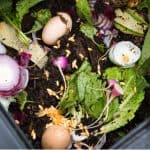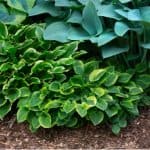Last updated on October 4th, 2023
Our site is reader supported, this means we may earn a small commission from Amazon and other affiliates when you buy through links on our site.
Compost is a wonderful way to recycle things from your home and give your garden an important supplement. With compost, you can add nutrient-rich humus to your garden that restores depleted soil and encourages plant growth. Composting is good for the environment, good for your plants, and easy to make.
Although the council now give every home a green bin to recycle your garden and kitchen waste in the UK, we still recommend recycling your own waste and turning it into compost because it helps reduce the number of trucks on the road and it all helps the environment. Plus, you can make some good compost that is usually far better than the alternatives you can buy from your local garden centre. So let’s get started!
Composting Benefits
Composting creates rich humus for your garden that adds nutrients to your soil and helps to improve moisture retention and, in turn, helps plants get all the nutrients they need. It can be the single most effective supplement to any of your gardening endeavours. With compost, you can introduce microscopic organisms that aerate your soil and help prevent plant diseases. By using compost as a natural alternative to any type of fertiliser, you can avoid the introduction of harmful chemicals to your garden and best of all it’s usually free to make, except for the initial investment in a good compost bin or compost tumbler.
Composting can use up to 30% of your household waste, which takes away the amount of waste you would overwise put in the green bin. The organic matter needs a lot of air to quickly decompose and when it gets tossed into landfills, without the air it needs, it creates methane gas, which adds to global warming concerns.
What to Compost
All of the materials you add to your compost bin need to be carbon or nitrogen-based. Carbon-rich elements include things like coffee filters, branches and twigs (but these are best shredded), leaves, bark chips, bits of wood, eggshells, moss from your lawn after scarifying, straw and even wood ash from your garden incinerator or woodburning stove.
All of these things provide a light, fluffy body to your compost. You want to have more carbon elements than you do nitrogen elements. The nitrogen elements you need to include are protein-rich items such as green leaves, food scraps such as vegetables and fruit, green lawn clippings but mix them in well because they can become sloppy moss and finally manure from pets such as horses, rabbits, hamsters.
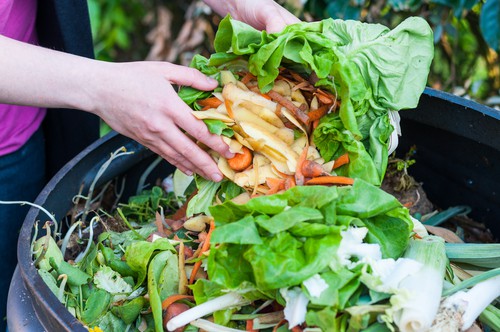
Getting a Good Mix of Green and Brown Materials
It is best to have two thirds brown material for every one third of green material, but this is only a rough guide and can vary depending on what you have the most of. The bulkiness of your carbon-based brown material is what allows oxygen to penetrate the organisms. If you have too much green waste (nitrogen elements) it will create a smelly and slow to decompose mass.
To maintain good hygiene with your compost you should cover any of the nitrogen-rich materials with carbon materials. The nitrogen-based materials release odours when they come into contact with the air while the carbon-rich materials provide a fresher scent. You will know if you’ve done things wrong because the smell will tell you.
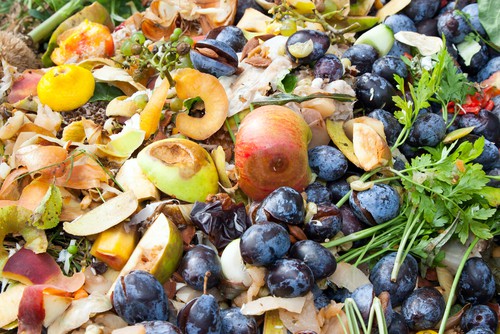
Below is a list to help you determine the category for compostable items:
Carbon-based items that can be composted:
- Wood chips and wood pellets.
- Ash from garden incinerators or wood burning stoves.
- Straw or hay from animal bedding or when used in your garden.
- Shrub pruning – larger clippings are best shredded with a garden shredder first.
- Shredded paper.
- Pine needles from conifers.
- Newspaper – coloured magazines are best shredded first.
- Leaves.
- Corn stalks and cobbs.
- Cardboard.
Nitrogen-based items that can be composted:
- Seaweed and kelp.
- Table scraps such as vegetables and fruit.
- Tea leaves.
- Grass clippings but mix them in well.
- Lawn and garden weeds but avoid perennials and weed heads.
- General plant cuttings.
- Coffee grounds.
- Animal manure from chickens, rabbits and horses.
What not to Compost
Watch for bananas and oranges that have been treated with pesticides
If you buy bananas or oranges, the banana peels and orange rinds could have pesticides on them, depending on where you purchase them from, so you need to be very careful if you choose to include these items in your compost.
Avoid diseased plants and perennial weeds
If you are going to use your compost to fertilise food plants such as potatoes and tomatoes it’s best not to include pet manure. Do not add diseased plant growth either because this can spread diseases, or perennial weeds and weed flowers heads that have gone to seed as these seeds could spread from the compost and infiltrate your garden wherever the compost is applied.
Be careful not to attract mice and rats
Unless you have a composter with a lid that you can lock, avoid fish scraps, meat scraps, or bones. Do not include them because they will attract pests such as mice and rats although they can be composted otherwise.
You can learn more in detail about what to compost and what not to compost here.
Storing your kitchen waste before adding it to your compost bin
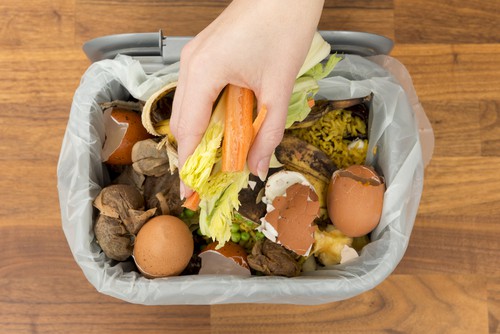
Most people have a mini compost bin they store in the kitchen before they transfer it to the composter outside. If you’re going to store your kitchen waste you should get a container that has a lid and a handle, usually, a stainless steel compost container will come with an air filter to help cut down on the smell. You will be very grateful for this addition if you are going to compost regularly. You can store your bin under the sink until it’s time to transfer the material to your compost bin outside.
Breaking down garden waste
A big component in compost is usually garden waste from the garden and these materials decompose at different rates. So, if you want to expedite the composting process is best to cut up everything you add into smaller more manageable pieces. If you throw large branches and thick pieces of wood or debris onto your pile it will decompose eventually but it will take much longer, and in the process, slow down the decomposition of all the other elements in your compost bin.
Invest in a garden shredder for green and brown waste
This is where we recommend a good garden shredder that can shred both green waste and brown waste, including kitchen waste. We reviewed a garden shredder by Bosch here that can shred both types of waste ready for being added to your compost bin to help speed up the process.
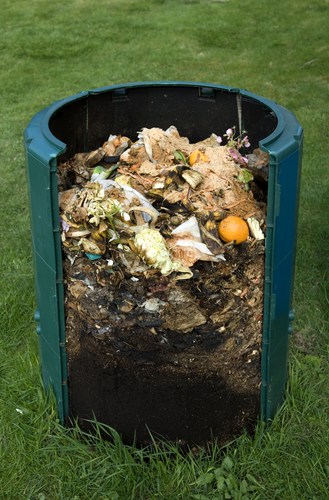
Getting the correct ratio of waste
Given the ratio of nitrogen elements to carbon elements, you might end up with too many leaves to add to your balanced compost bin. In which case you can make a separate secondary pile of leaves, this also can be made into leaf mould instead of composting. You can find a place with adequate drainage and shade so that the pile never dries out and stack the leaves about 10cm in diameter and 8cm in height. Then include a layer of soil in between each pile.
The pile should be damp enough that when you take a handful of it and squeeze, a few drops of moisture appear. You don’t want these leaves to be packed too tightly and within about 5 months the material will become dark and crumbly, perfectly composted and available to add as you would a fertiliser to any other part of your garden for nutritional value.
How to compost outside
The first thing to consider is if you want to make a compost heap, build a compost bin or buy one. Ideally, you want to choose or make a compost bin with no bottom. If you have one with a bottom then we recommend using a good layer of soil at the bottom before starting to fill the compost bin. Whatever type of compost bin you buy or make, the process of making compost of basically the same.
Step 1
When you are ready to compost you want to start the pile on bare earth. The reason for this is to allow organisms like worms to access the pile and help aerate the compost.
Step 2
The first layer should be comprised of hedge trimmings, twigs or straw to help aerate the total pile and add some drainage.
Step 3
After that, you can add your waste in layers alternating between a dry layer like wood ash, straw and or leaves followed by a wet or moist layer such as food scraps or tea bags. Ideally, you want the final layer to be garden waste if possible to cover any kitchen waste to help avoid attracting mice and rats.
Add manure or any other nitrogen source to activate your compost pile and expedite the decomposition process. You can also buy compost makers from garden centres for this very job, and generally, it just speeds up the composting process.
You want the pile to remain moist so if it is raining adequately you don’t have to do anything but if it’s not you should water occasionally.
Step 4
Cover the pile with anything that you have, such as plastic sheeting or wood to help the compost maintain moisture and heat up inside naturally. Every few weeks turn the pile with a compost aerator, you can also use a garden fork or a shovel to aerate it and allow oxygen to infiltrate all areas of the compost heap.
Once your compost pile is established you can start adding new materials by mixing them into the existing pile instead of adding them in layers as you do initially.
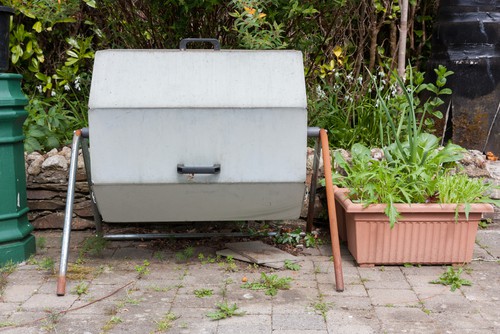
Investing in a compost bin or tumbler
You can always purchase a compost bin or compost tumbler (as pictured above) that you keep outside rather than creating your own. If you purchased one yourself it’s well worth choosing one that has a rotating tumbler so that you can easily turn your mixture about.
There are many an option for compost bins, some of which don’t require much from you, some that are large and meant for open spaces with others intended for smaller urban use. So, figure out what your needs are and what your goals are for the compost when deciding on the investment to make.
We recently reviewed some good compost bins, and you can see these here.
- 4 Best Moisture Meters For Wood
- 4 Best Lawn Levelling Rakes: Tested & Reviewed for Quick and Easy Results
- Best Knapsack Sprayers – My top models I use as a professional gardener
- 7 Best Long Reach Hedge Trimmers, Testing, Buyer’s Guide and Reviews
- 5 Strongest Industrial Weedkillers – Kills Everything & Professional Grade

